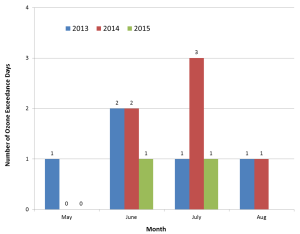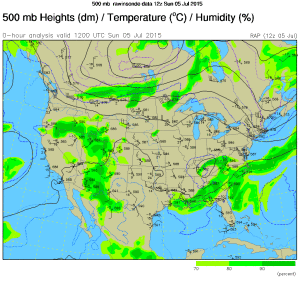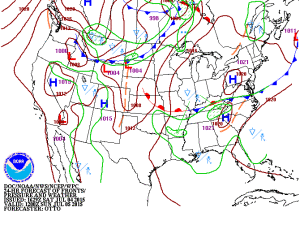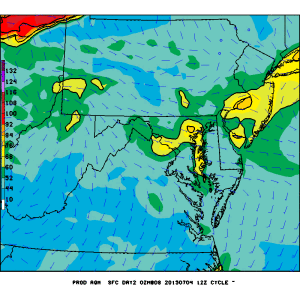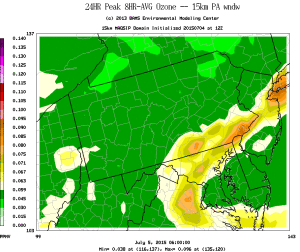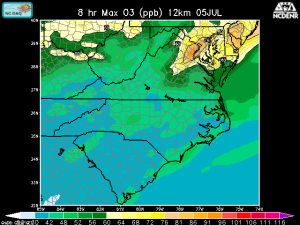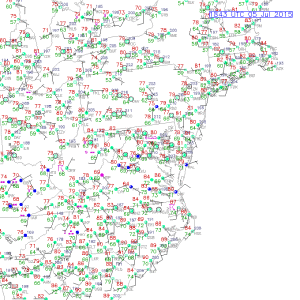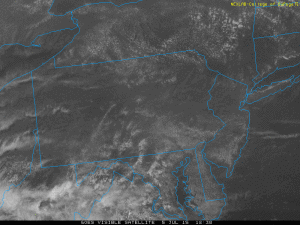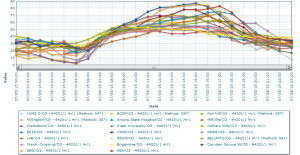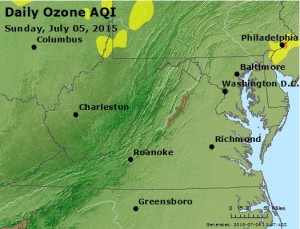Medium Range Air Quality Outlook
Mid-Atlantic Region
Issued: Wednesday, July 8, 2015
Valid: July 9 – 13, 2015 (Tuesday – Saturday)
Summary:
The weather models are consistent in building a broad upper level ridge over the south/central US by Saturday, which will promote sunny skies over the Mid-Atlantic throughout the weekend. As a result, the chances for USG ozone will increase to Marginal on Saturday and Sunday. The location of the ridge will allow Moderate ozone and PM2.5 to persist across the southern Mid-Atlantic (e.g., southern VA, NC) through at least Sunday. Elsewhere, widespread clouds and showers today and tomorrow associated with a stalled frontal boundary will limit ozone precursors available on Friday when the sun first appears in full force. By Saturday, however, the atmosphere will be prime for ozone formation into the Moderate along the I-95 Corridor range with light westerly surface winds and a high pressure center over western VA keeping skies clear throughout the region. On Sunday, model discrepancies make the forecast uncertain, but clear skies are expected for most of the region. This will promote another day of rising ozone throughout most of the Mid-Atlantic, likely limited to the Moderate range due to the lack of workday traffic. By Monday, the weather models show very different upper level features above the region, but both create an area of widespread rain and scattered showers, bringing the ozone forecast back into the Good range. Particles are another story, however, as another plume of Canadian wildfire smoke will dip into the Mid-Atlantic Friday through Sunday. The impacts of this smoke will keep daily particle concentrations at varying Moderate concentrations throughout most of the period.
Discussion:
The weather models are in general consensus on the synoptic features for most of the medium range period, but diverge somewhat by Saturday evening. The 06Z NAM, 06Z GFS, and 00Z ECMWF were consulted for this analysis. Currently, a substantial shortwave over eastern Canada is dropping a slowing cold front through the northern Mid-Atlantic (NMA), which is expected to stall near the PA/MD border this evening. Shortwaves embedded in the flow will trigger a considerable surface wave that will move over PA tomorrow, bringing clouds, rain, and areas of convection to the NMA. An upper level ridge becomes apparent in the weather models early Friday, with its axis stretching from the Northern Plains southeastward to the northern Mississippi River Valley. As this feature slowly broadens and moves eastward, spanning almost the entire CONUS, the Mid-Atlantic will get a break from the clouds and rain for Friday and much of Saturday. Although there is model agreement in developing a “Ring of Fire” scenario of successive short waves cresting the ridge aloft on Sunday and Monday, discrepancies arise regarding the timing and impacts of the shortwaves themselves. The GFS brings a strong shortwave into PA around 00Z Sunday, with resulting clouds and precipitation moving through the central Mid-Atlantic (CMA) throughout the day Sunday before the upper level feature exits off the Delmarva coast. On the other hand, the EC solution brings no shortwaves over the Mid-Atlantic until 18Z Sunday, making for clear and calm weather throughout the entire weekend. Although there is general consensus between models regarding the large scale features throughout the medium range period, the timing of these shortwaves will have implications for air quality along the I-95 Corridor for the coming weekend. On Monday, although the characteristics of the embedded shortwaves over the Mid-Atlantic varies between models, they both show resultant cloudy skies and scattered showers across the region. Both of the models are trending toward re-developing a longwave trough over the Great Lakes/eastern US, with a corresponding area of low pressure at the surface. For future forecasts, it is worth noting that the GFS cuts off the upper level low over the Ohio River Valley (ORV) on Tuesday. As next week approaches, this feature may become an important factor in determining the Mid-Atlantic forecast if it continues to appear in the weather model solutions.
A surface wave currently over AR will move along the frontal boundary dipping southeastward as a cold front through PA today. By the time this surface wave reaches the Mid-Atlantic on Thursday, the front will still be stalled along the PA/MD border. There are still some differences among the forecast models regarding the timing of the wave, which will move into southwestern PA in the afternoon. The GFS and EC are about 3 hours faster than the NAM; we follow WPC, which sides with the GFS and EC. This wave will bring widespread heavy rain and convection to the NMA tomorrow afternoon and evening, with resultant cloud cover not reaching much farther south than northern VA as the front is dragged northward into PA. These clouds and rain will limit ozone to the Good range. PM2.5 continues in the mid-Moderate range this morning in locations along and ahead of the cold front, but has quickly dropped into the Good range behind the front. In particular, hourly concentrations are reaching into the 30s ug/m3 this morning at locations along the I-95 Corridor between DC and PHL. With the front stalling near the Mason-Dixon Line tomorrow, PM2.5 will likely linger in the Moderate range along and south of the front. However, we expected PM2.5 concentrations to decrease lower into the Moderate range due to periods of heavy rain this evening into tomorrow.
A mid-level ridge is developing today over the Southeastern US and will continue to build through the end of the medium range period. This feature will keep warm and sunny conditions across the southern Mid-Atlantic (SMA; e.g., southern VA and NC) at least through Sunday. As a result, the SMA will experience persistent Moderate ozone and PM2.5 conditions. PM2.5 buildup will be promoted by the continued presence of Saharan dust and Canadian wildfire smoke.
Early Friday, a developing area of surface high pressure over MI will help to push the frontal boundary southward towards the VA/NC border. Thursday’s clouds and showers will move eastward out to sea, allowing clear skies to take over the entire Mid-Atlantic by 18Z Friday. A ridge to our west is prominent in both the 850 and 500 mb analyses. Although ozone concentrations may rebound into the Moderate range at isolated locations, USG is very unlikely due to the plethora of clouds and rain over the region on Wednesday and Thursday, as well as the advection of slightly cooler and drier air from the northwest. The NRL NAAPS model shows another plume of smoke dipping southward into the region on Friday as surface winds shift northerly, which could push PM2.5 concentrations higher into the Moderate range throughout the region. As usual, the I-95 Corridor is of particular concern due to increased weekday emissions in the atmosphere along and downwind of the interstate.
Saturday is the first possible day of interest due to continued sunny skies and light, westerly surface winds as the upper level ridge continues to build. More widespread Moderate ozone is possible, particularly along the I-95 Corridor. But rising ozone should be kept in check by a variety of factors, including temperatures only slightly above average, a lack of a strong area of high pressure overhead, and back trajectories from the Great Lakes. The NAAPS model shows a large plume of wildfire smoke dipping into the Mid-Atlantic on Saturday, reaching as far south as the GA coastline. In the Mid-Atlantic, up to 8 additional ug/m3 of smoke is predicted to be present in the atmosphere. This smoke event is taking place on a weekend, which will help to limit additional particle buildup despite the relatively calm conditions. Since the air quality models do not take these plumes of smoke into account in their analyses, they are only showing narrow areas of Moderate ozone and PM2.5 on Saturday along the coastline. However, if the smoke forecast verifies, particles as well as ozone precursors will be abundant, causing widespread Moderate conditions of both PM2.5 and ozone.
By Sunday, model discrepancies make the air quality forecast for the end of the weekend a tricky one. If the GFS solution verifies, a surface wave will bring a period of clouds and rain eastward across the CMA throughout the day on Sunday, keeping ozone concentrations down and helping to rid the atmosphere of some of the lingering smoke. This solution shows the bulk of the rain staying south of the greater PHL area, making it the main metropolitan area of concern when it comes to air quality on Sunday. However, if the EC solution verifies, the entire Mid-Atlantic would see another day of clear skies, calm winds, and increasing ozone concentrations as well as the continued presence of several additional ug/m3 of smoke in the atmosphere. The WPC surface analysis is showing a blend of the two model solutions, with a surface high pressure center over WV taking the side of the EC, but also developing a surface wave of weak low pressure over the Delmarva around 12Z Sunday. At this time it is too early to deterministically select a model to believe, so a blend is best – meaning that scattered areas of clouds and some showers are most probable along the Chesapeake Bay area due to the developing surface wave, with neither completely clear skies nor a washout most likely.
On Monday, although the models fail to come back into agreement on upper level shortwave patterns, they do agree that some kind of widespread clouds and showers will impact the Mid-Atlantic due to increasing troughiness over the Great Lakes/eastern US. Regardless of the exact source of this cloud cover and rain, the consensus of shrouded skies and onshore transport aloft are enough to expect Good air quality on Monday at this time with some confidence.
– Eherts/Huff



